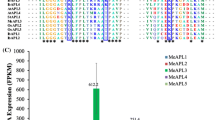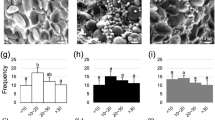Abstract
Cassava is an important starchy and food crop; however, the commercial value of cassava is seriously constrained by postharvest physiological deterioration (PPD). In this study, the molecular mechanism underlying PPD was studied by comparative physiological and transcriptomic analyses. Physiological analyses indicated that the contents of H2O2 and malondialdehyde (MDA), and the activities of superoxide dismutase (SOD) and catalase (CAT) all increased along with PPD development. Further transcriptomic analysis investigated the distribution of the differential expression profiling and identified a total of 10,347 differentially expressed genes (DEGs) during PPD. Notably, most of the genes encoding antioxidant enzymes and protein kinases showed significant upregulation at transcriptional levels, indicating the activation of antioxidant system and kinase-mediated signaling pathway during the PPD process. In addition, the genes involved in the starch synthesis pathway were repressed, whereas the genes associated with the starch degradation pathway were induced, thus leading to a decrease in starch content during the PPD process. Together, this study yields new insight into the transcriptional regulation network during the PPD process and provides potential gene resources for the delay of PPD in cassava.





Similar content being viewed by others
Change history
13 November 2021
A Correction to this paper has been published: https://doi.org/10.1007/s11105-021-01322-6
References
Asano T, Hayashi N, Kikuchi S, Ohsugi R (2012) CDPK-mediated abiotic stress signaling. Plant Signal Behav 7:817–821.https://doi.org/10.4161/psb.20351
Bredeson JV, Lyons JB, Prochnik SE et al (2016) Sequencing wild and cultivated cassava and related species reveals extensive interspecific hybridization and genetic diversity. Nat Biotechnol 34:562–570. https://doi.org/10.1038/nbt.3535
FAO, IFAD (2000) The world cassava economy, facts, trends and outlook. Food and Agriculture Organization and International Fund for Agricultural Development of the United Nations, Rome, Italy.
García JA, Sánchez T, Ceballos H, Alonso L (2013) Non-destructive sampling procedure for biochemical or gene expression studies on post-harvest physiological deterioration of cassava roots. Postharvest Bio Tec 86:529–535. https://doi.org/10.1016/j.postharvbio.2013.06.026
Hu W, Kong H, Guo Y et al (2016) Comparative physiological and transcriptomic analyses reveal the actions of melatonin in the delay of postharvest physiological deterioration of cassava. Front Plant Sci 7. https://doi.org/10.3389/fpls.2016.00736
Huang J, Bachem C, Jacobsen E, Visser RGF (2001) Molecular analysis of differentially expressed genes during postharvest deterioration in cassava (Manihot esculenta Crantz) tuberous roots. Euphytica 120:85–93. https://doi.org/10.1023/A:1017555605219
Iyer S, Mattinson DS, Fellman JK (2010) Study of the early events leading to cassava root postharvest deterioration. Tropical Plant Biol 3:151–165. https://doi.org/10.1007/s12042-010-9052-3
Jammes F, Song C, Shin D et al (2009) MAP kinases MPK9 and MPK12 are preferentially expressed in guard cells and positively regulate ROS-mediated ABA signaling. Proc Nat Acad Sci USA 106:20520–20525. https://doi.org/10.1073/pnas.0907205106
Kimura S, Waszczak C, Hunter K, Wrzaczek M (2017) Bound by fate: The role of reactive oxygen species in receptor-like kinase signaling. Plant Cell 29:638–654. https://doi.org/10.1105/tpc.16.00947
Kung JE, Jura N (2016) Structural basis for the non-catalytic functions of protein kinases. Structure 24:7–24. https://doi.org/10.1016/j.str.2015.10.020
Lebot V (2009) Tropical root and tuber crops: cassava, sweet potato, yams and aroids. CABI, Wallingford (United Kingdom)
Ma Q, Zhang T, Zhang P, Wang ZY (2016) Melatonin attenuates postharvest physiological deterioration of cassava storage roots. J Pineal Res 60:424–434. https://doi.org/10.1111/jpi.12325
Møller IM, Jensen PE, Hansson A (2007) Oxidative modifications to cellular components in plants. Annu Rev Plant Biol 58:459–481. https://doi.org/10.1146/annurev.arplant.58.032806.103946
Morante N, Sánchez T, Ceballos H et al (2010) Tolerance to postharvest physiological deterioration in cassava roots. Crop Sci 50:1333–1338. https://doi.org/10.2135/cropsci2009.11.0666
Prochnik S, Marri PR, Desany B et al (2012) The cassava genome: current progress, future directions. Tropical Plant Biol 5:88–94. https://doi.org/10.1007/s12042-011-9088-z
Reilly K, Bernal D, Cortés DF, Gómez-Vásquez R, Tohme J, Beeching JR (2007) Towards identifying the full set of genes expressed during cassava post-harvest physiological deterioration. Plant Mol Biol 64:187–203. https://doi.org/10.1007/s11103-007-9144-0
Reilly K, Góomez-Váasquez R, Buschmann H, Tohme J, Beeching JR (2004) Oxidative stress responses during cassava post-harvest physiological deterioration. Plant Mol Biol 56:625–641. https://doi.org/10.1007/s11103-005-2271-6
Reilly K, Han Y, Tohme J, Beeching JR (2001) Isolation and characterisation of a cassava catalase expressed during post-harvest physiological deterioration. Biochim Biophys Acta, Gene Struct Expression 1518:317–323. https://doi.org/10.1016/S0167-4781(01)00195-6
Rudi N, Norton G, Alwang J, Asumugha GN (2010) Economic impact analysis of marker-assisted breeding for resistance to pests and post harvest deterioration in cassava. Afr J Agr Resour Econ 04. https://doi.org/10.1109/iccsp.2013.6577072
Salcedo A, Siritunga D (2011) Insights into the physiological, biochemical and molecular basis of postharvest deterioration in cassava (Manihot esculenta) roots. Am J Exp Agr 1:414–431. https://doi.org/10.9734/AJEA/2011/784
Sánchez T, Dufour D, Moreno JL, Pizarro M, Aragón IJ, Domínguez M, Ceballos H (2013) Changes in extended shelf life of cassava roots during storage in ambient conditions. Postharvest Bio Tec 86:520–528. https://doi.org/10.1016/j.postharvbio.2013.07.014
Saravanan R, Ravi V, Stephen R, Thajudhin S, George J (2016) Post-harvest physiological deterioration of cassava (Manihot esculenta)-a review. Indian J Agr Sci 86:1383–1390
Trapnell C, Pachter L, Salzberg SL (2009) TopHat: discovering splice junctions with RNA-Seq. Bioinformatics 25:1105–1111. https://doi.org/10.1093/bioinformatics/btp120
Trapnell C, Roberts A, Goff L, Pertea G, Kim D, Kelley DR, Pimentel H, Salzberg SL, Rinn JL, Pachter L (2012) Differential gene and transcript expression analysis of RNA-seq experiments with TopHat and Cufflinks. Nat Protoc 7:562–578. https://doi.org/10.1038/nprot.2012.016
Uarrota VG, Maraschin M (2015) Metabolomic, enzymatic, and histochemical analyzes of cassava roots during postharvest physiological deterioration. BMC Res Notes 8:648. https://doi.org/10.1186/s13104-015-1580-3
Uarrota VG, Moresco R, Coelho B, Nunes EC, Peruch LAM, EdeO N, Rocha M, Maraschin M (2014) Metabolomics combined with chemometric tools (PCA, HCA, PLS-DA and SVM) for screening cassava (Manihot esculenta Crantz) roots during postharvest physiological deterioration. Food Chem 161:67–78. https://doi.org/10.1016/j.foodchem.2014.03.110
Uarrota VG, Moresco R, Schmidt EC, Bouzon ZL, da Costa NE, de Oliveira NE, Peruch LAM, Rocha M, Maraschin M (2016) The role of ascorbate peroxidase, guaiacol peroxidase, and polysaccharides in cassava (Manihot esculenta Crantz) roots under postharvest physiological deterioration. Food Chem 197:737–746. https://doi.org/10.1016/j.foodchem.2015.11.025
Vanderschuren H, Nyaboga E, Poon JS, Baerenfaller K, Grossmann J, Hirsch-Hoffmann M, Kirchgessner N, Nanni P, Gruissem W (2014) Large-scale proteomics of the cassava storage root and identification of a target gene to reduce postharvest deterioration. Plant Cell 26:1913–1924. https://doi.org/10.1105/tpc.114.123927
Vlaar P, van Beek P, Visser R (2007) Genetic modification and its impact on industry structure and performance: post-harvest deterioration of cassava in Thailand. J Chain Network Sci 7:133–142. https://doi.org/10.3920/JCNS2007.x083
Wang L, Feng Z, Wang X, Wang X, Zhang X (2010) DEGseq: an R package for identifying differentially expressed genes from RNA-seq data. Bioinformatics 26:136–138. https://doi.org/10.1093/bioinformatics/btp612
Wang W, Feng B, Xiao J et al (2014) Cassava genome from a wild ancestor to cultivated varieties. Nat Commun 5:5110. https://doi.org/10.1038/ncomms6110
Xu J, Duan X, Yang J, Beeching JR, Zhang P (2013) Enhanced reactive oxygen species scavenging by overproduction of superoxide dismutase and catalase delays postharvest physiological deterioration of cassava storage roots. Plant Physiol 161:1517–1528. https://doi.org/10.1104/pp.112.212803
Yan Y, Wang L, Ding Z, Tie W, Ding X, Zeng C, Wei Y, Zhao H, Peng M, Hu W (2016) Genome-wide identification and expression analysis of the mitogen-activated protein kinase gene family in cassava. Front Plant Sci 7. https://doi.org/10.3389/fpls.2016.01294
Zidenga T, Leyva-Guerrero E, Moon H, Siritunga D, Sayre R (2012) Extending cassava root shelf life via reduction of reactive oxygen species production. Plant Physiol 159:1396–1407. https://doi.org/10.1104/pp.112.200345
Funding
This work was supported by the National Natural Science Foundation of Hainan Province (2019RC290), the National Natural Science Foundation of China (31801419), the 2020 Research Program of Sanya Yazhou Bay Science and Technology City (SKJC-2020-2-002), the Central Public-Interest Scientifc Institution Basal Research Fund for the Chinese Academy of Tropical Agricultural Sciences (1630052017021, 1630012019009, 1630052019023), and the Central Public-Interest Scientific Institution Basal Research Fund for the Innovative Research Team Program of the Chinese Academy of Tropical Agricultural Sciences (17CXTD-28, 1630052017017), and the earmarked fund for the Modern Agro-industry Technology Research System (CARS-11-HNGJC).
Author information
Authors and Affiliations
Contributions
Data curation, Yan Yan and Sihan Zhao; formal analysis, Yan Yan; funding acquisition, Yan Yan; investigation, Sihan Zhao; software, Zehong Ding and Weiwei Tie; supervision, Wei Hu; writing—original draft, Yan Yan; writing—review & editing, Wei Hu. All authors have read and agreed to the published version of the manuscript.
Corresponding author
Ethics declarations
Conflict of Interest
The authors declare that they have no conflict of interest.
Ethical Approval
This article does not contain any studies with human participants or animals performed by any of the authors.
Additional information
Key Messages
• The changes of physiological indexes during PPD process were analyzed.
• A total of 10347 differentially expressed genes were identified during PPD process.
• The DEGs involved in antioxidant system, starch metabolism, and protein kinases were identified during PPD.
Supplementary Information
Below is the link to the electronic supplementary material.
Rights and permissions
About this article
Cite this article
Yan, Y., Zhao, S., Ding, Z. et al. Comparative Transcriptomic Analysis of Storage Roots in Cassava During Postharvest Physiological Deterioration. Plant Mol Biol Rep 39, 607–616 (2021). https://doi.org/10.1007/s11105-020-01274-3
Received:
Accepted:
Published:
Issue Date:
DOI: https://doi.org/10.1007/s11105-020-01274-3




